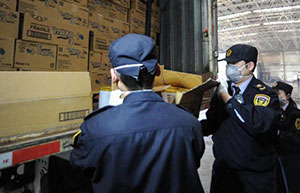Climate change adaptation at local level
By Wang Binbin (China Daily) Updated: 2014-04-03 08:17On Monday, the Intergovernmental Panel on Climate Change published the second installment of its Fifth Assessment Report and delivered a strong warning that climate change is already affecting every continent, and that all people are vulnerable to extreme weather events. It also warned water scarcity will worsen as water supplies are being affected by the changes in precipitation, temperature and radiation.
Regarding China's situation, yields of winter wheat, a strain of the grain planted in the fall, could be benefiting from warming temperatures and higher precipitation in places such as the Huang-Huai-Hai Plain, a large alluvial area in northern China with deposits from the Yellow River and Huai Hai. However, yields of rice are projected to decrease in eastern China and elsewhere in Asia.
Climate change is also challenging China's water supplies and this is being exacerbated by the country's growing population, which is increasing the demand for water, particularly in northern China. With population numbers projected to increase and lifestyles shifting, it is not clear how it will be possible for everyone in this country to get enough healthy food and clean water.
It is worth noting that this IPCC report, for the first time, allocated a chapter to the subject of livelihoods and poverty. People in rural areas are heavily dependent on natural resources and directly influenced by changes in weather patterns and climate.
The IPCC report confirmed that governments at all levels are starting to develop adaptation plans and policies. However, particularly in developing countries, there is an enormous funding gap and growing adaptation deficit, that is, poor countries are being affected by extreme weather events to an increasingly high degree of severity compared to rich countries. Oxfam estimates that poor countries received just 2 percent of their adaptation funding needs from rich countries in the three years since the Copenhagen climate summit in 2009.
In recent years, the Chinese government has dedicated more and more attention to climate change adaptation. During recent talks in Warsaw in November 2013, China unveiled the National Strategy of Climate Change Adaptation, emphasizing the need to integrate responses into development plans and to enhance adaptive capacities. However, for planners and practitioners, climate change adaptation presents new and unique challenges. Planners, especially at the provincial and local level, still lack the ability to access and use climate information. They do not have tried and tested tools at their disposal to assess the long-term impact of climate change on poor people and to choose and evaluate the effectiveness and sustainability of different adaptation methods.
Community-based adaptation is increasingly gaining acceptance as a promising and wise approach to climate change and development, thanks to its focus on participation by vulnerable people. And adaptation needs to be effectively integrated into community-development planning processes. In China, there are still about 128 million people living below the national poverty line, which is defined as an annual income of 2,300 yuan ($374). Most of these people are not living in the main grain-producing areas, and they depend on natural resources to feed themselves and sustain their livelihoods. These poor people are, for the most part, living in the most ecologically vulnerable areas and are themselves extremely vulnerable to the impacts of climate change.
A project in Shaanxi province launched by Oxfam and its local partners shows how the community-development planning processes can work. Yujiashan village is located in a drought-prone highland area of Shaanxi province in northwestern China, on the Loess Plateau. It has an annual precipitation of 600 millimetres. The village has 159 households and a total population of 643 people. Rain-watered agriculture and off-farm activities comprise the villagers' main sources of income. The villagers have reported seeing longer periods of rainfall which have caused floods as well as severe droughts in recent years. Nowadays, the main grain crops are winter wheat and spring corn, with soy beans and sweet potatoes as alternatives.
The local development plan focuses mainly on finding engineering solutions. But such a strategy might fail to address climate threats and future development needs. Therefore, Oxfam and other non-governmental organizations in the area have been working with the local authorities to test and demonstrate the effectiveness of different methods for promoting sustainable livelihoods that have a market focus.
While the project's social, economic and environmental impacts remain to be seen, it at least shows that meaningful and practical solutions can be effected at the local level, with the participation of the community, government departments, scholars and NGOs.
The author is manager of Climate Change and Poverty at Oxfam Hong Kong.
- Banking on brighter prospects
- Traditional banking perceived as more secure
- Jack Ma invests $532m in financial software firm
- China may sell debt to combat climate change
- COFCO to take 51% stake in Noble Agri for $1.5b
- Cashing in on Internet Protocol Television
- Alibaba's IPO architect lays out blueprint
- Real land reform requires more than words

















